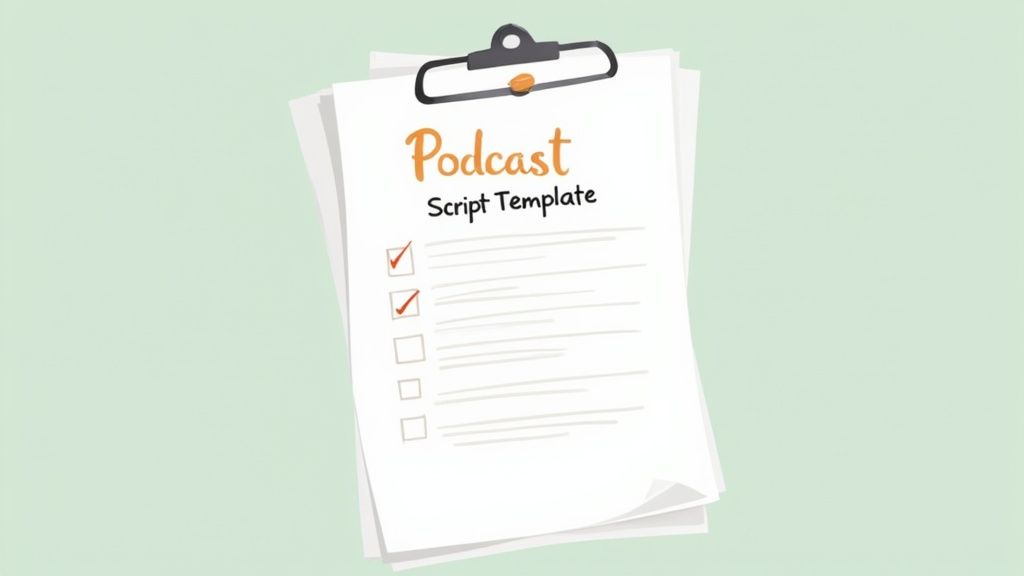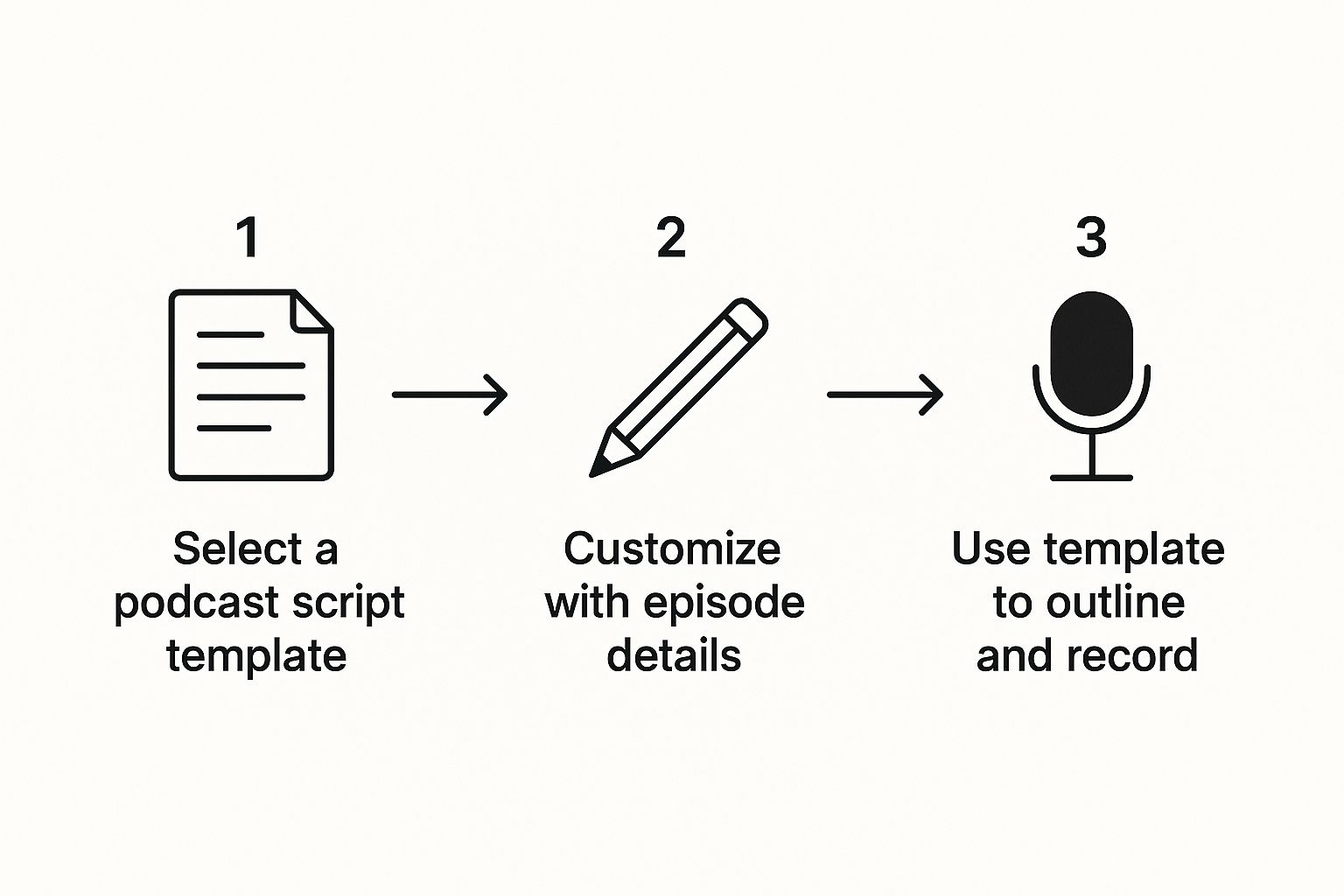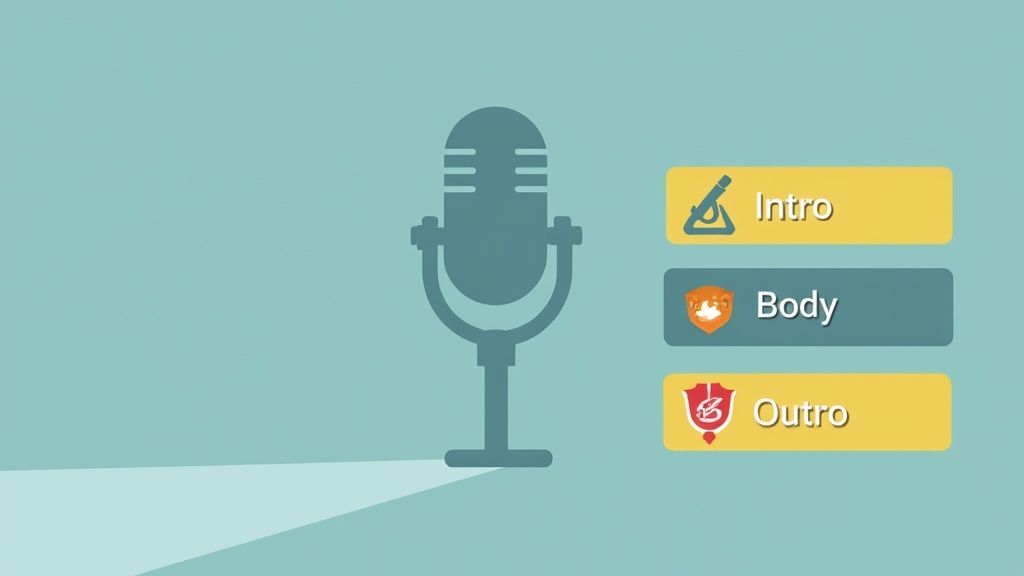A good podcast script template isn't just a document; it's your roadmap to a professional, engaging episode. It gives you the structure you need—from the hook to the final sign-off—making sure you deliver a clear, cohesive message without rambling.
Honestly, the biggest payoff is in the editing suite. A tight script saves you a ton of time.
Why a Script Is Your Podcast's Secret Weapon

Jumping into a recording session without a plan is one of the most common mistakes I see, especially in B2B podcasting where clarity and authority are everything. A lot of hosts worry a script will make them sound robotic, but I've found the opposite is true. A well-designed script template is more like a safety net. It gives you the confidence to stop worrying about what to say and start focusing on how you say it.
Think of it as the architectural blueprint for your episode. It’s what helps you:
- Stay on Message: A script keeps you laser-focused on the core topics, killing the tangents that waste your listener's time.
- Deliver Value Consistently: It's your guarantee that you'll hit every key point, statistic, and call-to-action, which is what separates a polished episode from an amateur one.
- Boost Your Confidence: Knowing you have a solid structure allows you to relax and just talk, even when the subject matter gets complex.
Finding Your Scripting Style
Now, "script" doesn't have to mean a word-for-word document you read like a robot. The best approach really depends on your personal style and the format of your show.
For some, a detailed outline with bullet points for each segment is plenty of structure. This works great for interview-style shows where you want a more conversational, free-flowing feel. For others, particularly solo shows or episodes packed with complex data, a more detailed script ensures you nail the accuracy and keep the flow smooth.
The truth is, scripting is becoming the norm because listener expectations for quality have gone way up. In a market with over 4.5 million podcasts, a structured approach is one of the best ways to keep your audience coming back. If you want to dig deeper into the planning phase, you can explore this detailed podcast planning guide.
A podcast script isn't a cage; it's a launchpad. It frees you from worrying about what to say next so you can focus on how you say it. It’s the difference between a rambling chat and a powerful, authoritative conversation.
Before we dive into building your own template, let's break down the essential pieces that make a script work.
Here’s a quick-glance table breaking down the core components every effective podcast script needs, from the hook to the final call to action.
Essential Components of a Winning Podcast Script
Having these components mapped out is the first step. Next, we'll look at how to bring them all together into a flexible, reusable template that works for your show.
Building Your Podcast Script Template Block by Block
A solid podcast script template isn't just a document; it's a modular system you can bend and shape for any episode. I like to think of it like building with LEGOs—each block serves a purpose, and how you snap them together creates the final structure.
Let's break down the essential components you absolutely need.
This simple workflow shows how a template can turn a potentially chaotic process into a streamlined production line, from the first idea to the final recording.

The real value here is turning a messy creative endeavor into a repeatable, efficient system.
The Pre-Roll Checklist
Forget hitting record for a second. The pre-roll sets the stage for a smooth session. This stuff never makes it into the final audio, but it’s a non-negotiable part of your template.
- Tech Check: Is your mic, software, and headset actually working? Seriously, check it every time.
- Guest Warm-Up: If you have a guest, spend five minutes just chatting off-the-record. It builds rapport and calms everyone's nerves.
- Environment Scan: Silence your phone. Close those 27 browser tabs. Make sure the dog isn't about to start barking.
The Intro: Your Hook and Welcome
You have less than a minute to convince a new listener to stick around. Your intro has to be tight, energetic, and packed with value right from the jump.
The first 30 seconds are critical. Start with a powerful hook—a surprising statistic, a provocative question, or even a juicy snippet from later in the episode. From there, roll your theme music, introduce yourself and the topic, and give a quick preview of what’s in it for them.
Example Intro Snippet:
(Sound of a phone buzzing, then silence)
"How many times has that sound derailed your focus today? What if you could reclaim three hours of deep work every single week? On this episode, we're breaking down the three-step framework to do just that. Welcome to..."
Main Segments and Transitions
This is the meat of your episode. Don't script every single word. Instead, break your topic down into 2-4 distinct segments. Use bullet points under each one to list key talking points, data you want to reference, or stories you need to tell. This structure keeps you on track but still allows for a natural, spontaneous delivery.
Just as important are the transitions—the segues that connect these segments. A well-placed transition guides the listener logically from one idea to the next, making sure the episode doesn't feel disjointed or random. For a deeper dive on this, check out our full guide on how to write a podcast script.
Sponsor Slots and CTAs
Even if you don't have sponsors yet, build the slots into your template now. It makes life so much easier later. Drop a marker for a pre-roll (before the intro music) and a mid-roll (at a natural break between segments).
Your main Call to Action (CTA) needs to be crystal clear and singular. Pick the one thing you want listeners to do—subscribe, download a resource, check out your website—and state it clearly in the outro. Don't give them a laundry list of options.
The Outro: Your Final Impression
The outro is your chance to wrap everything up with a bow. It’s your last opportunity to reinforce the episode’s value and build a real connection with your listener.
- Summarize Key Takeaways: Briefly recap the most important points.
- Deliver Your Call to Action: Again, clearly state what you want the listener to do next.
- Thank Your Guest and Audience: A little gratitude goes a long way in building a community.
- Tease the Next Episode: Give them a reason to come back for more.
- Fade to Outro Music: End it on a clean, professional note.
Adapting Your Template for Different Podcast Formats

Let's be real: a one-size-fits-all podcast script template just doesn't work. The real magic of a template is in its flexibility. Your script should serve your format, not box it in.
Whether you're doing a deep-dive interview or hosting a rowdy panel discussion, the structure has to bend without breaking. The demand for high-quality, efficient content is only growing—in the US alone, 55% of people over 12 are now monthly podcast listeners. That's a huge audience with high expectations, and a solid, adaptable script is your secret weapon.
For Interview Shows
When your format is a one-on-one interview, your script is less about what you'll say and more about crafting a narrative arc with your guest. It's all about the story.
- Group questions thematically. Don't just fire off a random list. Think in chapters: "The Early Days," "The Turning Point," and "What's Next." This turns a Q&A into a compelling journey.
- Leave room for the unexpected. I always add a bullet point for potential follow-ups under each main question. It’s a simple trick that forces you to listen actively instead of just rushing to the next item on your agenda.
An interview script should be a compass, not a cage. It guides the conversation toward a valuable destination but gives you the freedom to explore interesting detours along the way.
For Solo Episodes
Flying solo is a different beast entirely. Without a conversational partner, your script becomes your co-host, keeping the energy up and the narrative clear. It’s your job to keep things moving.
Your template needs to break the episode into distinct, bite-sized segments with clear transitions. This is crucial for avoiding a monotonous block of audio that sends listeners scrambling for the skip button. I like to use bolded keywords to remind myself where to add emphasis or take a strategic pause. It’s a small detail, but consistent quality is a huge part of how to grow a podcast.
For Co-Hosted or Panel Shows
With multiple voices in the mix, a script is your best friend for preventing chaos. The goal is to manage the flow and make sure everyone gets a chance to contribute without constantly talking over each other.
A great way to do this is by assigning specific questions or segments to each host right in the template. This creates a natural rhythm and ensures the conversation feels balanced. For more complex setups, using a tool like Descript, a video and audio editor that transcribes as you go, can be a game-changer for organizing who says what.
How to Sound Natural and Not Robotic
The number one fear every new podcaster has? Sounding like they’re reading an essay into a microphone. We've all heard shows like that, and they're an instant turn-off.
To dodge this trap, you have to write for the ear, not the eye. This isn't about crafting perfect, grammatically flawless sentences. It's about capturing the rhythm of a real conversation.
For starters, use contractions. Say "don't," "it's," and "you're." Nobody says "it is" in a normal chat. Keep your sentences short and to the point. A good rule of thumb? If you can't say it in one breath, it’s too long. The single best thing you can do is read your script out loud. You'll immediately catch those clunky phrases that looked fine on paper but sound completely unnatural.
Find Your Balance
This is where a lot of people go wrong—they write out every single word. Instead, try using bullet points for your main talking points. This is a technique our founder, Tom Hunt, swears by. It gives him just enough structure to stay on track but leaves plenty of room to be spontaneous. That's the secret sauce that makes a B2B podcast feel like a genuine conversation, not a presentation.
Think of your script as a guardrail, not a cage. A few simple tricks can make all the difference:
- Mark Up Your Script: Don't just leave it as a block of text. Go through and bold or italicize words you want to hit harder. Scribble notes in the margins for where to pause, slow down, or inject a bit of energy. This tiny step turns a flat document into a dynamic performance guide.
- Embrace Imperfection: Let go of the need to be perfect. If you stumble over a word or rephrase something on the fly, roll with it. Those little "mistakes" are what make you sound human. Listeners connect with real people, not flawless AI voiceovers.
A great podcast script template doesn't box you in; it gives you the confidence to be yourself. It’s the structure that frees you up to focus on what really matters: your delivery, your connection with the guest, and having a real conversation.
Rehearsing doesn't mean memorizing. It means getting comfortable with the flow of your ideas so you can speak with authority and confidence. This preparation is a non-negotiable part of effective podcast marketing—a polished, natural delivery is what creates those shareable, high-impact moments.
Turning Your Script Into a Marketing Engine
A great episode is one thing, but a great podcast script template? That's a marketing asset in disguise. Your script is an absolute goldmine for content, turning one recording session into a full-blown campaign that actually drives business.
Think about it. A well-structured script makes it ridiculously easy to pull out the good stuff. You can instantly spot the key takeaways, the most quotable moments, and those juicy data points that are perfect for creating audiograms and short video clips.
These little snippets are the fuel for any decent social media strategy. At Fame, this is exactly what our B2B Social Media Agency lives for—taking those core moments and blowing them up across platforms like LinkedIn to build your authority and get you in front of the right people.
Repurpose Your Script for Maximum Impact
It doesn’t stop with social clips. The topics and talking points you've already outlined in your script are the perfect foundation for other powerful marketing materials. Each episode's core theme can be effortlessly expanded into:
- In-depth blog posts that start pulling in SEO traffic.
- Thought leadership articles for your LinkedIn profile.
- Valuable email newsletters that keep your audience engaged.
This is how your podcast transforms from a standalone piece of content into a legitimate lead-generation machine. By using your script to feed your entire content engine, you create a cohesive message that resonates everywhere. It's a system. Services like our B2B Email Newsletter Agency can help you build that system, making sure you actually nurture the audience you're working so hard to attract.
For a complete playbook on getting your show out there, check out our B2B growth guide on how to market your podcast.
Still Have Questions About Podcast Scripting?
Even with a killer template in your back pocket, a few questions always seem to pop up. It's totally normal. Here are some of the most common ones I hear from podcasters just getting into the scripting groove.
How Long Should A Script Be For A 30-Minute Episode?
Everyone wants a magic number here. A common rule of thumb you'll see tossed around is about 150 words per minute. So for a 30-minute show, you're looking at a massive 4,500-word document.
But let me be blunt: please don't do that. Scripting every single word is a surefire way to sound like you're reading from a teleprompter.
Instead, think in terms of a detailed outline with bullet points. Allocate rough timings for each section of your show. This gives you the structure you need to stay on track without stripping all the natural conversation and personality out of your recording.
What are effective B2B podcast promotion strategies?
To make your corporate podcast a success, you can't just publish and hope for the best. Effective B2B podcast promotion strategies are multi-faceted and focus on maximizing reach and impact with your target audience.
- Leverage Your Guests: Your guests are your most powerful marketing channel. Equip them with a promotional toolkit including pre-written social posts, custom audiograms, and quote graphics to make sharing effortless.
- Repurpose Aggressively: One episode should fuel content for weeks. Turn key insights into LinkedIn articles, create short video clips for social media, and use the transcript as a base for a detailed blog post. This is a core function of how podcast marketing services boost audience growth.
- Strategic Cross-Promotion: Identify non-competing podcasts that share your target audience. Arrange for episode swaps or guest appearances to tap into an existing, engaged listener base.
- Paid Amplification: Use targeted ads on platforms like LinkedIn to promote your best clips to specific job titles, industries, or companies.
- Internal Promotion: Don't forget your internal team. Encourage employees to share episodes on their personal networks to extend your reach authentically.
What are the benefits of investing in B2B podcast promotion?
Investing in B2B podcast promotion transforms your show from a simple content piece into a strategic business asset. The primary benefits include:
- Enhanced Brand Visibility and Authority: Consistent promotion places your brand in front of a targeted audience, establishing your company as a thought leader in your niche. Professional podcast marketing services significantly boost a company's visibility by strategically distributing your content across multiple channels.
- High-Quality Lead Generation: B2B podcasts attract a highly engaged, professional audience. Promoting your episodes ensures you reach decision-makers, creating a direct pipeline of qualified leads who are already invested in your expertise.
- Content Multiplication: Promotion services excel at repurposing a single episode into dozens of micro-assets (clips, articles, social posts). This maximizes your content ROI without requiring more recording time.
- Audience Growth and Community Building: Strategic promotion is the key driver for audience growth. It helps you attract and retain subscribers, building a loyal community around your brand that can be nurtured through other channels, like email newsletters.
- Competitive Advantage: While many companies start a podcast, few promote it effectively. A dedicated promotion strategy sets you apart, ensuring your voice is heard above the noise and capturing market share.
Comprehensive podcast marketing services for B2B startups often package these promotional activities with production, ensuring a cohesive strategy from recording to lead capture. The packages offered by B2B podcast promotion services typically include social media management, content repurposing, guest outreach, and performance analytics to deliver measurable results.
For those wondering how to get past the main bottlenecks of a podcast guesting campaign, a structured promotional plan is the answer.
Ready to turn your B2B podcast into an authority-building, lead-generating machine? At Fame, we build and market podcasts that drive real business results. Learn more about how we can help you.

